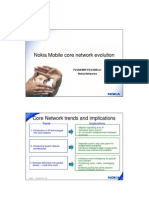ISP: Internet Service Provider: Email Services Domain Registration Web Hosting
ISP: Internet Service Provider: Email Services Domain Registration Web Hosting
Uploaded by
venkateswararao mCopyright:
Available Formats
ISP: Internet Service Provider: Email Services Domain Registration Web Hosting
ISP: Internet Service Provider: Email Services Domain Registration Web Hosting
Uploaded by
venkateswararao mOriginal Title
Copyright
Available Formats
Share this document
Did you find this document useful?
Is this content inappropriate?
Copyright:
Available Formats
ISP: Internet Service Provider: Email Services Domain Registration Web Hosting
ISP: Internet Service Provider: Email Services Domain Registration Web Hosting
Uploaded by
venkateswararao mCopyright:
Available Formats
Page-1
ISP: Internet Service Provider
Internet service was originally limited to government agencies and specific university departments. The
technology was developed to provide access to the general public through the World Wide Web in the late
1980s
ISP stands for Internet Service Provider. It is a company that provides internet access to both personal and
business customers. ISP provides the services to surf the web, shop online, and connect with family and
friends all for a fee.
ISPs can also provide other services, including email services, domain registration, web hosting,
and browser packages.
An ISP may also be referred to as an information service provider, a storage service provider, an internet
network service provider (INSP), or any combination of these three based on the services offered by the
company.
For example, when you connect to the Internet, the connection between your device and the internet is
executed through a transmission technology that involves the transfer of information packets through an
Internet Protocol route.
Data is transmitted through different technologies, including cable modem, dial-up, DSL, high speed
interconnects. Accordingly, based on the method of data transmission, the Internet access provided by ISPs
can be divided into many types, some of which are as follows:
1). Dial-up Internet access:
It is the oldest technology to provide Internet access by modem to modem connection using
telephone lines. In this method, the user's computer is connected to a modem with a telephone
line. This method has become outdated today due to slow connection speed. However, in remote
areas, this method can be used where the broadband network is not available.
Prepared By: M.VENKAT ( MCA, M-Tech) Lecturer in Computer Science
Page-2
2). DSL:
DSL, which stands for 'digital subscriber line' is an advanced version of the dial-up Internet access
method. It uses high frequency to execute a connection over the telephone network and allows the
internet and the phone connection to run on the same telephone line. This method offers an
Asymmetric Digital Subscriber (ADSL), where the upload speed is less than the download speed,
and a Symmetric Digital Subscriber Line (SDSL), which offers equal upload and download speeds.
Out of these two, ADSL is more popular among users and is popularly known as DSL.
3). Wireless Broadband (WiBB):
It is a modern broadband technology for Internet access. It allows high-speed wireless internet
within a large area. To use this technology, you are required to place a dish on the top of your house
and point it to the transmitter of your Wireless Internet Service Provider (WISP).
4. Wi-Fi Internet:
It is the short form for "wireless fidelity," which is a wireless networking technology that provides
wireless high-speed Internet connections using radio waves. To use the internet, you are required to
be within the range of Wi-Fi network. It is commonly used in public places such as hotels, airports,
restaurants to provide internet access to customers.
Prepared By: M.VENKAT ( MCA, M-Tech) Lecturer in Computer Science
Page-3
5). ISDN:
It is a short form of Integrated Services Digital Network. It is a telephone system network which
integrates a high-quality digital transmission of voice and data over the same standard phone line. It
offers a fast upstream and downstream Internet connection speed and allows both voice calls and
data transfer.
6). Ethernet:
It is a wired LAN (Local Area Network) where computers are connected within a primary physical
space. It enables devices to communicate with each other via a protocol (a set of rules or common
network language). It may provide different speeds such as 10 Mbps, 100 Mbps and 10 Gbps.
Prepared By: M.VENKAT ( MCA, M-Tech) Lecturer in Computer Science
You might also like
- Flipkart & Amazon Project PDFDocument61 pagesFlipkart & Amazon Project PDFShweta Vijay78% (9)
- SWOT of An ISPDocument26 pagesSWOT of An ISPMaruf HasanNo ratings yet
- Speed of Light Communications and the Internet Protocol (IP)From EverandSpeed of Light Communications and the Internet Protocol (IP)Rating: 4 out of 5 stars4/5 (1)
- Questions: Tutorial Questions: Week 03 For Lecture 2: IP ProtocolsDocument2 pagesQuestions: Tutorial Questions: Week 03 For Lecture 2: IP ProtocolsDoan Tue TamNo ratings yet
- Ccna1 V7 Cap 1-3Document6 pagesCcna1 V7 Cap 1-3ask_gaby100% (1)
- Internet ConceptsDocument66 pagesInternet ConceptsmuruganNo ratings yet
- s2 Networkingfundamentalsunit1Document7 pagess2 Networkingfundamentalsunit1Ruel AlejandroNo ratings yet
- ClassX CA NotesDocument75 pagesClassX CA NotesAshutosh TripathiNo ratings yet
- Internet and Its ApplicationsDocument22 pagesInternet and Its Applicationsvishnu kumarNo ratings yet
- Classifications: Access Providers ISPDocument8 pagesClassifications: Access Providers ISPEL A VeraNo ratings yet
- Class 10 Computer Chapter 1 Internet Basics NotesDocument16 pagesClass 10 Computer Chapter 1 Internet Basics NotesSheluNo ratings yet
- "Internet Access Via TV Cable Networks": Miss - Anjali Prakash RathodDocument24 pages"Internet Access Via TV Cable Networks": Miss - Anjali Prakash RathodvedunknownNo ratings yet
- What Is ICT: Information and Communication Technology (Ict)Document152 pagesWhat Is ICT: Information and Communication Technology (Ict)shireen4844No ratings yet
- Basic Internet Skills: INTERNET - A Vast Global Communications Network With Billions of Webpages. Internet RefersDocument14 pagesBasic Internet Skills: INTERNET - A Vast Global Communications Network With Billions of Webpages. Internet RefersMylene RodriguezNo ratings yet
- InternetDocument20 pagesInternetvenkateswararao mNo ratings yet
- Internet AccessDocument29 pagesInternet AccessRomeo ManaNo ratings yet
- 6 Chapter 3 The Internet and World Wide WebDocument20 pages6 Chapter 3 The Internet and World Wide Webgreat.joyboy8080No ratings yet
- IT UNIT 4&5Document43 pagesIT UNIT 4&5jeevijeevitha361No ratings yet
- Internet Service Provider: Prepared By: Ankit SharmaDocument13 pagesInternet Service Provider: Prepared By: Ankit SharmaAnkit SharmaNo ratings yet
- Internet Connection & Regulating Understanding Website, Surfing, and InternetDocument60 pagesInternet Connection & Regulating Understanding Website, Surfing, and Internetangel cruzNo ratings yet
- IT - The InternetDocument3 pagesIT - The Internetbhettyna noayNo ratings yet
- PART B - Unit-4 Session-2 Networking FundamentalsDocument4 pagesPART B - Unit-4 Session-2 Networking Fundamentalsar3701471No ratings yet
- Internet Basics FullDocument12 pagesInternet Basics FullTECNICAL ADITYANo ratings yet
- IT AV Browser&MailDocument6 pagesIT AV Browser&MailmeghtNo ratings yet
- Broadband Technology: Under The Guidance Of: Ms - RupaliranaDocument23 pagesBroadband Technology: Under The Guidance Of: Ms - RupaliranaDaman Deep Singh ArnejaNo ratings yet
- Internet Service ProviderDocument20 pagesInternet Service Providerjatinmec100% (1)
- Iwd - Unit 1Document20 pagesIwd - Unit 1kirthikprathap07No ratings yet
- 1b Connecting To The Internet-1-1-1Document7 pages1b Connecting To The Internet-1-1-1maxmanuu001No ratings yet
- Introduction To Computer NetworkingDocument4 pagesIntroduction To Computer NetworkingDeepak KesharwaniNo ratings yet
- Chap 7 - Introduction to InternetDocument17 pagesChap 7 - Introduction to InternetJoseph PERSONNENo ratings yet
- MplsDocument124 pagesMplsmgitecetechNo ratings yet
- Computer NetworkDocument13 pagesComputer Networksami benamerNo ratings yet
- UNIT - 1 The Internet and World Wide Web E-Commerce Infrastructure-IIDocument24 pagesUNIT - 1 The Internet and World Wide Web E-Commerce Infrastructure-IINeelam PandyaNo ratings yet
- Web Technologies For Beginners: Part 1 - Introduction To InternetDocument19 pagesWeb Technologies For Beginners: Part 1 - Introduction To InternetUtsav SinhaNo ratings yet
- St. Xavier'S College: Maitighar, KathmanduDocument10 pagesSt. Xavier'S College: Maitighar, KathmanduAaditya Raman SinghNo ratings yet
- Networking Data1Document60 pagesNetworking Data1Vamshi BoddulaNo ratings yet
- Web ApplicationDocument19 pagesWeb Applicationmaxankur30No ratings yet
- Discovery II Chapter 1 1.1.1 The Internet StandardsDocument10 pagesDiscovery II Chapter 1 1.1.1 The Internet StandardsNaveed SultanNo ratings yet
- Summer Vacation HomeworkDocument49 pagesSummer Vacation HomeworkUnnati JoshiNo ratings yet
- Topic For Discussion. Network BasicsDocument2 pagesTopic For Discussion. Network BasicsUrmom FuckerNo ratings yet
- Comuter Networks & Web Technology - Revision Notes 12aDocument20 pagesComuter Networks & Web Technology - Revision Notes 12aLiaNo ratings yet
- 1.introductionc Mobile Computingc CC C CC C C C C C C CDocument4 pages1.introductionc Mobile Computingc CC C CC C C C C C C CFiqri MohidinNo ratings yet
- IT - The InternetDocument3 pagesIT - The Internetbhettyna noayNo ratings yet
- Communication Network and Internet ServicesDocument8 pagesCommunication Network and Internet ServicesTharankithabaskaranNo ratings yet
- Computer Networks & Internet TechnologiesDocument13 pagesComputer Networks & Internet Technologiesgiana 4eNo ratings yet
- Internet Access Via Cable TV NetworkDocument15 pagesInternet Access Via Cable TV Networkankur_desai100% (1)
- Ict ReviewerDocument7 pagesIct ReviewerRiriNo ratings yet
- InternetDocument19 pagesInternetVatsal ChangoiwalaNo ratings yet
- Java BcanotesDocument80 pagesJava BcanotesRohan raoNo ratings yet
- Khush Bakht BAF173006 Sameer Hussain Shah BBA173016 Osama Sajjad Butt BBA173034Document11 pagesKhush Bakht BAF173006 Sameer Hussain Shah BBA173016 Osama Sajjad Butt BBA173034Hamza KhaliqNo ratings yet
- Summary For The Prelims: E-Commerce and Internet MarketingDocument12 pagesSummary For The Prelims: E-Commerce and Internet MarketingDexter AlcantaraNo ratings yet
- Contact No. 9469860788Document11 pagesContact No. 9469860788uniqueone346No ratings yet
- My Seminar TopicDocument11 pagesMy Seminar Topicnafeesabanu524_90318No ratings yet
- MI&K Eyuti 3Document7 pagesMI&K Eyuti 3አረጋዊ ሐይለማርያምNo ratings yet
- Computer Networks and Communications: Specification of Mobile ComputingDocument5 pagesComputer Networks and Communications: Specification of Mobile ComputingSuEz AzIzNo ratings yet
- E-Commerce-Final 111Document25 pagesE-Commerce-Final 111Stephanie AndalNo ratings yet
- Chapter 1Document5 pagesChapter 1arjunp20No ratings yet
- Advanced Computer NW Assingment (Presentation) Best PDFDocument44 pagesAdvanced Computer NW Assingment (Presentation) Best PDFJiru MuletaNo ratings yet
- E Commerce PptDocument17 pagesE Commerce Pptchaudharydemi786No ratings yet
- An Internet Service ProviderDocument23 pagesAn Internet Service ProviderGlocer BartolabaNo ratings yet
- Artikel Dan Contoh Soal (Bahasa Inggris)Document15 pagesArtikel Dan Contoh Soal (Bahasa Inggris)BWfool100% (1)
- 1.1what Is Broadband?Document30 pages1.1what Is Broadband?akashyadav433No ratings yet
- Unit 3Document11 pagesUnit 3nupurrcpacsNo ratings yet
- Structure and Union in CDocument11 pagesStructure and Union in Cvenkateswararao mNo ratings yet
- Unit-I Chapter 1Document32 pagesUnit-I Chapter 1venkateswararao mNo ratings yet
- C LAB ManualDocument8 pagesC LAB Manualvenkateswararao mNo ratings yet
- DLD Labs1Document1 pageDLD Labs1venkateswararao mNo ratings yet
- SushmitaDocument40 pagesSushmitaPriti BasforeNo ratings yet
- English: Comsats University IslamabadDocument4 pagesEnglish: Comsats University IslamabadCrypto CaravanNo ratings yet
- 11.6.6 Lab - Calculate IPv4 Subnets - ILMDocument4 pages11.6.6 Lab - Calculate IPv4 Subnets - ILMDylan YordanoNo ratings yet
- L5 Collaborative ICT DevelopmentDocument17 pagesL5 Collaborative ICT DevelopmentChad de la PeñaNo ratings yet
- Lecture 1 HTML & CssDocument92 pagesLecture 1 HTML & CssShabanaNo ratings yet
- Importance of English Communication For Engineering Students From Rural Areas and Its RemediesDocument4 pagesImportance of English Communication For Engineering Students From Rural Areas and Its RemediesbilbilNo ratings yet
- IP Routing: OSPF Configuration Guide, Cisco IOS Release 15M&TDocument448 pagesIP Routing: OSPF Configuration Guide, Cisco IOS Release 15M&Tranger_subscribeNo ratings yet
- Task Order Form-OF349+ - 057Document4 pagesTask Order Form-OF349+ - 057eye to eyeNo ratings yet
- Affiliate Marketing Action PlanDocument7 pagesAffiliate Marketing Action PlanSteven BellNo ratings yet
- GaBBA - CPTR 105 - Introduction To Computers - Rev3Document5 pagesGaBBA - CPTR 105 - Introduction To Computers - Rev3Tú NguyễnNo ratings yet
- Minor Project: Prepared byDocument11 pagesMinor Project: Prepared byTanya GuptaNo ratings yet
- A1 Worksheet - Explorer Task - Benefits of A Computer Network AnsweredDocument2 pagesA1 Worksheet - Explorer Task - Benefits of A Computer Network Answeredanimemaster2kNo ratings yet
- DM986 414 Ont DatasheetDocument8 pagesDM986 414 Ont DatasheetMiguel Angel CaraNo ratings yet
- Flodemir NokiaDocument3 pagesFlodemir NokiakhinhkhicauNo ratings yet
- Release Notes: Fortios 7.2.4Document62 pagesRelease Notes: Fortios 7.2.4Isaac Glez.No ratings yet
- Module 02 Report by Lara Alofi 2110886Document3 pagesModule 02 Report by Lara Alofi 2110886Inzamam NizamNo ratings yet
- Chapter 2Document24 pagesChapter 2Sue BrandrethNo ratings yet
- PDF Tools For Documents and Web PagesDocument13 pagesPDF Tools For Documents and Web PagesR. SaridaNo ratings yet
- How To Write Blog PostDocument4 pagesHow To Write Blog PostsandeepNo ratings yet
- Ultimate Guide To IptvDocument44 pagesUltimate Guide To IptvMuhammad Akhtar MalikNo ratings yet
- Customers' Online Shopping Preferences in Mass CustomizationDocument17 pagesCustomers' Online Shopping Preferences in Mass CustomizationLan ViNo ratings yet
- TECHNOLOGy IN 21st CENTURYDocument5 pagesTECHNOLOGy IN 21st CENTURYJayson Mendez100% (1)
- Nerde CookiesDocument5 pagesNerde Cookiespsx duperNo ratings yet
- IPK2 SIP Trunk Connections (114 KB)Document8 pagesIPK2 SIP Trunk Connections (114 KB)KetSaiNo ratings yet
- TN iVantageAPI T0000960 RevC 12 11 18Document176 pagesTN iVantageAPI T0000960 RevC 12 11 18Asad VakiliNo ratings yet
- Wireshark Lab 06Document16 pagesWireshark Lab 06Check OutNo ratings yet
- ACN Micro Project-1Document23 pagesACN Micro Project-1ashutosh dudhaneNo ratings yet





























































































